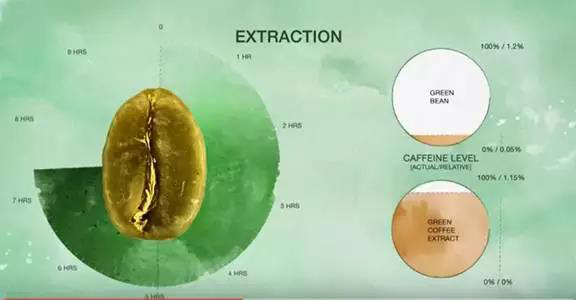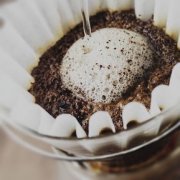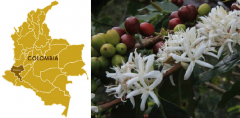The difference between low-caffeine coffee and ordinary coffee in the processing process of Colombian Swiss water-washed coffee
Professional coffee knowledge exchange more coffee bean information please follow the coffee workshop (Wechat official account cafe_style)
Basic knowledge and flavor description of Colombian coffee
Swiss water treatment
Caffeine is a magical substance, and many times in your life you are unwittingly consuming caffeine, Swiss water low-caffeine treatment:
Swiss Water Process, abbreviated as SWP, Swiss water decaffeinated treatment, not because water is Swiss, but because it was first invented and experimented successfully in Switzerland, and later was widely used for commercial purposes for decaffeination treatment. At present, most of the Swiss water decaffeinated treatment in the world is carried out in a treatment plant in Canada.
Its principle is: first, a batch of coffee beans, use hot water to dissolve all the substances, including flavor, of course, there is also the protagonist "caffeine", this solution is called GCE (Green Coffee Extraction)
The solution containing all these flavor substances is passed through a specific filter membrane in order to allow only caffeine to pass through, and then the remaining solution is used to soak the next batch of raw coffee beans, using the principle of dissolution balance. The saturated flavor substances in the solution will not be dissolved, and the new batch of raw beans will only dissolve caffeine, while the flavor substances will remain in the coffee raw beans.
Decaffeinated coffee is coffee with only a small amount of caffeine. The caffeine content in brewed coffee should not exceed 0.3%. In other words, a cup of decaf should contain no more caffeine than 5mg (usually a cup of 236mI coffee contains caffeine from 50mg to 200mg).
According to the FDA standard of the US Food and Drug Administration, the caffeine removal rate of decaffeinated coffee is not less than 97%, while the EU standard caffeine removal rate should reach 99.9%.
At present, the low-caffeine treatment method used in the coffee industry is the Swiss water treatment method, which first soaks a batch of raw beans in a high-pressure environment to dissolve all the flavor substances in the raw beans in water as much as possible, and discard the raw beans. Then use activated carbon to extract caffeine from the soaking solution, soak the same batch of raw beans with extracted caffeine, which is like pouring 75% concentrated salt water into 25% salt water. To achieve an average of 50% of the life harmony in the solution, because only the caffeine in the raw bean is incomplete, the caffeine in the raw bean will spontaneously dissolve into the soaking solution and retain other flavor factors in the raw bean, this method is relatively simple to operate, and the tail liquid treatment is not troublesome. There is almost no pollution in the process, and coffee beans can be treated in large numbers, which has become the most widely used commercial treatment method.
Colombia Swiss Water Process
Colombia is located in northwestern South America, bordering Venezuela and Brazil to the east, Ecuador and Peru to the south, Panama to the northwest, the Caribbean Sea to the north and the Pacific Ocean to the west. The land area is about 1.142 million square kilometers, ranking fourth in South America.
Colombia is the only country in South America that has the coastlines of the North Pacific and the Caribbean. The tropical rain forest is dominated by climate and rich in natural resources. Historically, it is an agricultural country that mainly produces coffee.
Colombia's mild climate, humid air, and diverse climate make it a harvest season all year round, with different kinds of coffee ripening at different times.
Colombian coffee is a very representative variety of Arabica coffee, its aroma is rich and thick, with clear high-quality acidity, high balance, sometimes with nutty flavor, endless aftertaste, regardless of appearance and quality. Colombian coffee is of high quality.
Country: Colombia
Grade: Excelso
Baking degree: medium baking
Treatment: Swiss water washing
Variety: Kaddura, Kaduai
Batches: selected microbatches
Flavor: nuts, dark chocolate, green tea
Suggestion on brewing parameters of hand-made Colombian decaf coffee
Hand-washed Colombian decaf beans. 15g powder, medium fineness grinding (sugar size), v60 filter cup, 88-89 degree water temperature, 30g water injection for the first time, steaming for 30 seconds, water injection to 105g water cut off, waiting for powder bed water to drop to half, then water injection, slow and uniform water injection until 225g water, finally, shake a filter cup to increase extraction, the ratio of water to powder is 1:15, and the extraction time is 2:04.
The decaffeination process is aimed at raw beans rather than ripe beans. It is difficult to remove caffeine without affecting other substances in coffee, such as sugars, cellulose, protein, citric acid and fruit acid.
Flavor description: cocoa, brown sugar, floral fragrance, green tea, sweet corn, juice-like touch, milk chocolate, medium and high alcohol thickness

Purchase link: https://item.taobao.com/item.htm?spm=a1z10.5-c.w4002-15673140460.20.26673e53zUL228&id=561279038738
Important Notice :
前街咖啡 FrontStreet Coffee has moved to new addredd:
FrontStreet Coffee Address: 315,Donghua East Road,GuangZhou
Tel:020 38364473
- Prev

The parameters of hand-made Colombian decaf coffee suggest that the flavor and taste characteristics of Swiss water-treated decaf coffee
Professional coffee knowledge exchange more coffee bean information please pay attention to the coffee workshop (Wechat official account cafe_style) Colombian coffee basic knowledge and flavor description of Colombian low-caffeine coffee brewing parameters suggest hand-flushing Colombian decaf beans. 15g powder, medium fineness grinding (sugar size), v60 filter cup, 88-89 degrees water temperature, 30g water injection for the first time.
- Next

Colombian Cauca Coffee Bean Flavor and Taste of Superior Cup Coffee Bean in Colombian Cauca Province
Professional coffee knowledge exchange more coffee bean information please follow the coffee workshop (Wechat official account cafe_style) Colombian coffee basic knowledge and flavor description Colombia Cauca Best Cup Regional Select Sua origin introduction: Cauca province, Cauca department, the name comes from the Cauca River, Cauca River. Located in southwestern Colombia
Related
- Detailed explanation of Jadeite planting Land in Panamanian Jadeite Manor introduction to the grading system of Jadeite competitive bidding, Red bid, Green bid and Rose Summer
- Story of Coffee planting in Brenka region of Costa Rica Stonehenge Manor anaerobic heavy honey treatment of flavor mouth
- What's on the barrel of Blue Mountain Coffee beans?
- Can American coffee also pull flowers? How to use hot American style to pull out a good-looking pattern?
- Can you make a cold extract with coffee beans? What is the right proportion for cold-extracted coffee formula?
- Indonesian PWN Gold Mandrine Coffee Origin Features Flavor How to Chong? Mandolin coffee is American.
- A brief introduction to the flavor characteristics of Brazilian yellow bourbon coffee beans
- What is the effect of different water quality on the flavor of cold-extracted coffee? What kind of water is best for brewing coffee?
- Why do you think of Rose Summer whenever you mention Panamanian coffee?
- Introduction to the characteristics of authentic blue mountain coffee bean producing areas? What is the CIB Coffee Authority in Jamaica?

